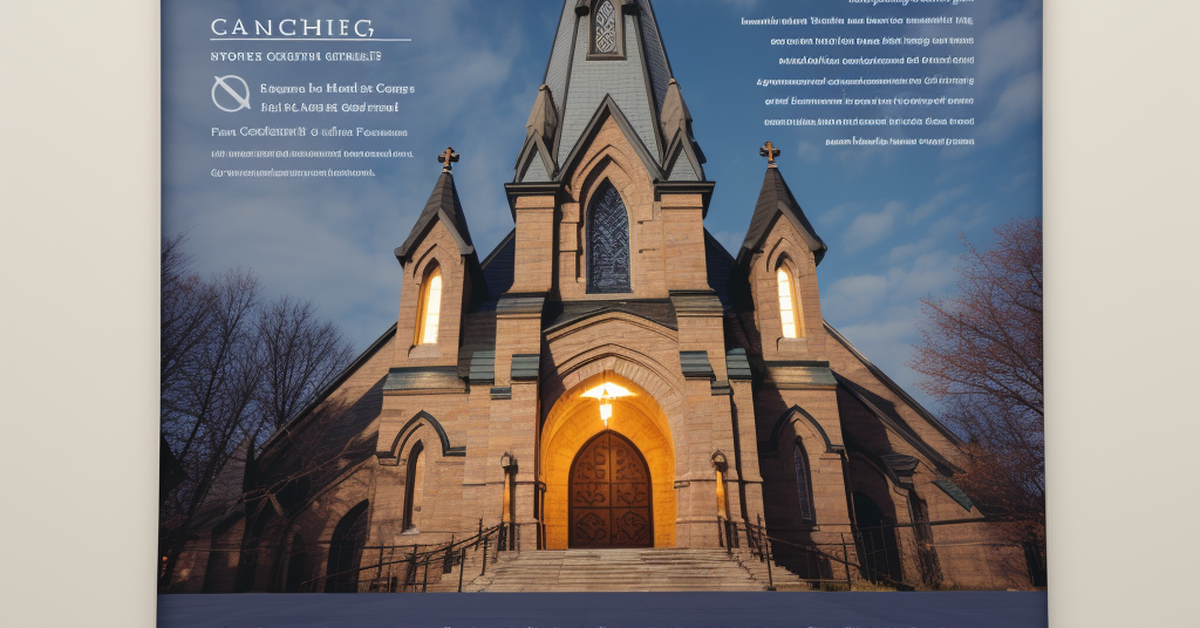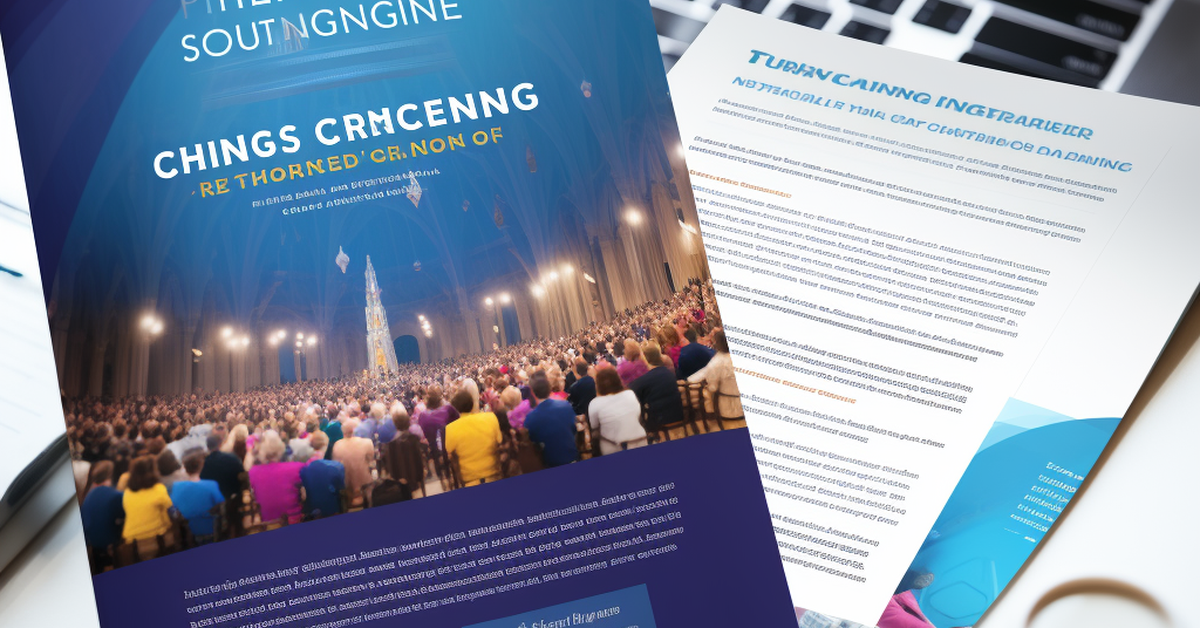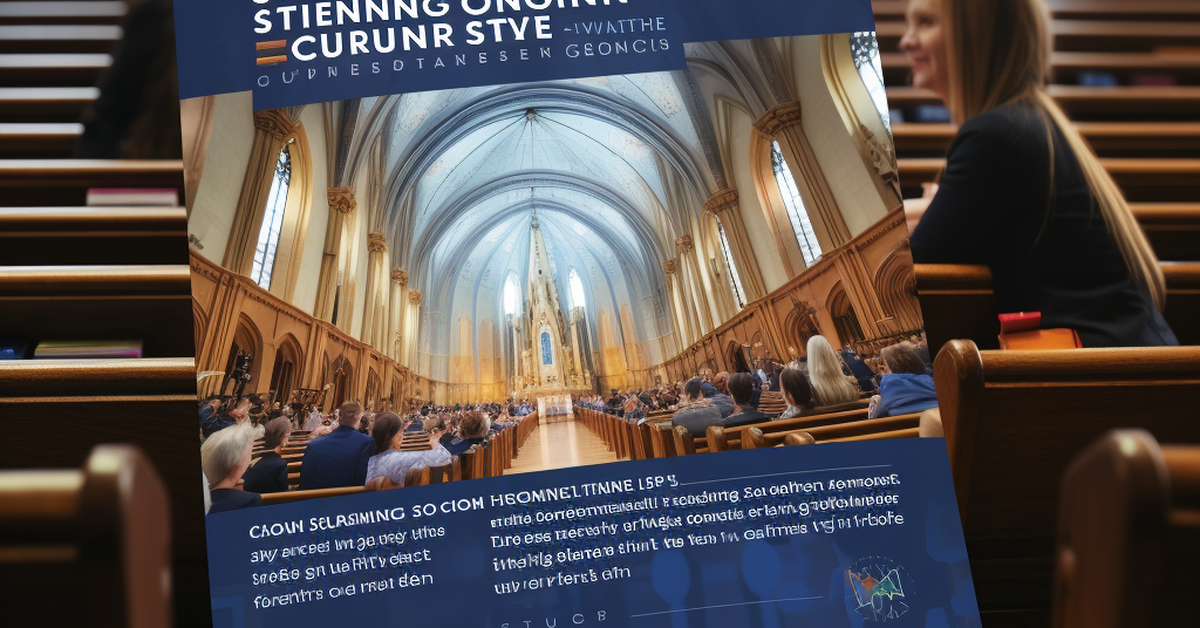Eyes wide with hope, the congregation gathers, hearts united on a mission to transform their sacred space. It’s the launch of a church capital campaign, an ambitious journey to rally financial support for a cause that extends well beyond the pews. Church capital campaigns are more than just fundraisers; they’re a call to faith, generosity, and community action. This guide offers insights into crafting a successful church fundraising campaign that resonates with both the spirit and the wallets of your congregation.
The story of each church is unique, woven from the threads of its believers, history, and aspirations. A capital campaign taps into this narrative, seeking funds for ventures such as new construction, refurbishment, or erasing a burdensome debt. It’s a delicate dance of communicating needs and inspiring generosity, where each step is choreographed to resonate with the faithful. The strategy is to build not just a building, but also a legacy—a testament to the congregation’s commitment to their community and faith.
As we turn the page to the next chapter, “What is a Church Capital Campaign?”, we carry with us the understanding that a successful campaign is a tapestry of strategic planning, heartfelt storytelling, and meticulous execution. It’s about planting seeds for a future where the church can flourish, supported by the sturdy roots of its members’ dedication and giving spirit. What follows is a blueprint for nurturing these seeds into a bountiful harvest that will sustain your church’s vision for years to come.
What is a Church Capital Campaign?

A church capital campaign is a focused fundraising effort. It aims to raise significant funds for substantial projects. Think building new facilities, refurbishing old ones, or retiring hefty debts. Unlike regular offering plates that cover day-to-day expenses, capital campaigns are for big-ticket items. These are initiatives that can propel a church forward, sparking new growth and expanded ministry reach.
Capital campaigns are vital. They involve the whole church community in a shared vision. They’re not just about money. They’re about uniting people with a purpose, to make lasting impacts on their church and community.
Imagine you’re setting out on a grand adventure. You have a goal, a map, and a team ready to join you. Launching a capital campaign is like that. It’s an expedition towards a monumental goal.
The distinction between capital campaigns and regular church giving
Normal giving is like the heartbeat of the church. It keeps the lights on and the doors open. Capital campaigns, though? They’re like the rocket boosters that launch the church into new orbits of ministry and service. Regular giving happens quietly in the background, but a capital campaign is a special season of sacrifice and vision.
The role of capital campaigns in church growth and development
Capital campaigns can be game-changers. They can fund a new sanctuary that welcomes more families. They can pay for a community center that serves the needy or give teens a place to call their own. These campaigns can literally set the stones for future generations to meet, learn, and grow.
Here’s a snapshot of what a campaign might look like:
| Phase | Task |
|---|---|
| Vision Casting | Share the dream with the congregation |
| Feasibility Study | Gauge the support and set goals |
| Public Phase | Get everyone involved |
| Follow-up | Ensure pledges turn into contributions |
A successful campaign hinges on clear communication. Your message must resonate with the hearts of your congregation. That’s where Church Fundraising Materials steps in. With over 600 clients served, they understand how to craft a message that inspires and motivates. They offer a suite of materials to support your campaign:
- Q&A brochures – answering those burning questions
- Pledge cards – making commitment tangible
- Donor letters – connecting personally with potential supporters
- Campaign brochures – painting the picture of what can be
For those seeking to raise less than $25,000, Church Fundraising Materials suggests looking online for cost-effective alternatives. For more substantial goals, their tailored services can make a significant difference.
As the journey of your capital campaign unfolds, you’ll see hearts and lives changed. Not just by the money raised, but by the unity and purpose ignited in your church community. And as you consider the steps ahead, remember that this adventure is just one part of a greater story. A story of growth, impact, and faith that continues to write itself with each new chapter your church embarks upon.
Planning your next chapter? Our resources can help script a successful narrative for your church’s future.
I, Stephen Lee, have served over 600 churches and Christian schools in their capital campaign fundraising. I understand the importance of these campaigns not just for meeting financial goals, but for fostering community and growth within the church. Through Church Fundraising Materials, I help organizations like yours craft a compelling visual message that resonates with your audience and supports your unique fundraising goals.
Why Conduct a Church Capital Campaign?

Churches often find themselves at a crossroads where their vision outgrows their wallet. That’s where a church capital campaign steps in. It’s not just about the money; it’s about bringing a community together for a common goal. When a church needs big bucks for a project like a new building or to zap away old debts, a capital campaign can be a game-changer.
Let’s break it down:
- Big Dreams, Big Needs: Say your church has dreams bigger than its current bank balance. A capital campaign can turn those dreams into reality, whether it’s for a new sanctuary or a much-needed renovation.
- Spiritual Growth: It’s not only about funds. It’s a chance for spiritual growth, where folks learn about giving and faith.
- Long-Term Success: These campaigns aren’t just a quick cash grab. They’re about setting up your church for the long haul.
Now, I’ve seen over 600 churches and Christian schools shoot for the stars with their fundraising dreams, and I can tell you, a well-run campaign can work wonders. It’s all about getting your message out there, clear and strong, so it hits home with potential donors.
The Impact of a Capital Campaign
Believe it or not, a capital campaign does more than just fill the collection plate. It can:
- Boost Engagement: It gets people excited and involved. They’re part of something big, something that’ll last.
- Strengthen Bonds: Working towards a shared goal can tie a congregation together like nothing else.
- Make Dreams Doable: With the right funds, what seemed impossible becomes very, very possible.
Here’s a little secret: people want to give. They just need to know why it matters.
Essential Elements of a Capital Campaign
- Clear Vision: You’ve got to spell out what you’re aiming for. Is it new pews or a parking lot? Make it clear.
- Solid Strategy: A plan that lays out how you’ll raise the cash and who will help.
- Community Involvement: Get everyone on board, from the choir to the ushers.
Remember, a successful campaign means more than reaching a financial goal. It’s about firing up your church for the future. Want to learn more about how to plan your own church capital campaign? Stick around, and we’ll guide you through the essentials of laying the groundwork for a campaign that’ll set your church on the path to a bright and bountiful future.
How to Plan a Successful Church Capital Campaign

Embarking on a church capital campaign is a bold step toward achieving significant goals such as building expansions, renovations, or reducing debt. Setting SMART goals—specific, measurable, achievable, relevant, and time-bound—is a cornerstone of success. These goals are your roadmap; they provide clear direction and enable tracking progress.
Building a campaign team brims with dedicated individuals. You need leaders and volunteers passionate about your church’s vision. They are the driving force, the ones who will rally the community and steward the campaign to fruition.
Developing a compelling vision is not just about crafting a message. It’s about creating a narrative that resonates with your congregation’s hearts and souls. When people see their contributions as part of a larger divine plan, generosity flows.
SMART Goals and Clear Objectives
| Objective Type | Example Objective | Expected Result |
|---|---|---|
| Specific | Renovate the church’s kitchen to serve community meals | Enhanced community outreach |
| Measurable | Raise $500,000 over six months | Clear fundraising target |
| Achievable | Secure pledges from 70% of the congregation | Realistic participation goal |
| Relevant | Fund a new youth center to support local families | Aligns with the church’s mission |
| Time-bound | Complete the capital campaign by the end of the year | Sets a clear deadline |
- Leadership and Volunteer Team
Recruit individuals who embody the spirit of your mission. They should be:
- Enthusiastic about the church’s future
- Skilled in various areas, from finance to outreach
- Committed to seeing the campaign through
- A Vision That Inspires Giving
Your vision should:
- Highlight the campaign’s impact on the community
- Be shared consistently across all communications
- Evoke a sense of unity and purpose within the congregation
Campaign Team Dynamics
A successful campaign leans on a strong team structure. You’ll want to structure your team around key roles such as:
- Campaign Chairperson
- Communications Coordinator
- Events Planner
- Pledge Manager
Each role is a cog in the machine, driving the campaign toward its end goal.
Crafting a Compelling Vision
Your vision isn’t just a statement; it’s a story. A narrative that weaves together the church’s past achievements, present challenges, and future aspirations. It’s a story that invites every member of the congregation to step into a shared future marked by faith and commitment.
When you look at the impact of a well-crafted vision, statistics show that campaigns with a strong, clear vision can see up to a 50% increase in pledge fulfillment. It’s a testament to the power of a shared dream.
The Call to Action
Encourage your congregation to act. Let them see their role in this grand endeavor. A simple, heartfelt call to action can be the nudge a potential donor needs to make a pledge. Remember, every contribution, big or small, forms part of the collective effort to reach your church’s goals.
Transitioning to Next Steps
As we gather our resources and fortify our resolve, let us remember that the foundation of any successful endeavor lies in strong leadership. The strength and guidance of those at the helm can steer us towards waters of abundance and grace. It is with this understanding that we look towards the guiding hands of our church leaders to carry forth the mission we have so passionately crafted together.
I, Stephen Lee, have had the privilege of serving over 600 churches and Christian schools in their capital campaign fundraising. My role has been to help these organizations visually communicate their vision in a way that deeply resonates with their intended audience. Through a blend of dedication and strategic design, Church Fundraising Materials provides solutions that profoundly impact fundraising efforts.
Remember, planning a successful church capital campaign is a journey of faith, strategy, and community. By following these steps and harnessing the power of a united congregation, your campaign is poised for success. If you’re ready to begin this transformative journey, feel free to explore additional insights and guidance on successful church capital campaigns.
The Role of Church Leadership in Capital Campaigns

Church leaders hold a pivotal role in steering a capital campaign towards success. Their involvement not only lends credibility but also inspires the congregation. Effective leaders train and empower their team to rally supporters around a shared vision for the church’s future.
- Leadership’s involvement sets the tone for the campaign.
- Training and empowering leaders boosts the campaign’s momentum.
- Cultivating a culture of generosity starts with the church leadership.
In any church capital campaign, the leadership’s commitment can make or break the endeavor. These individuals must not only endorse the campaign but be its most passionate advocates. They foster a culture where giving becomes a joy, not a duty.
A church leader’s role involves:
- Vision sharing: They articulate the campaign’s purpose with clarity and conviction.
- Strategic planning: Leaders work to map out a feasible plan.
- Donor engagement: Personal interactions with potential donors are key.
Consider this: a church leader’s enthusiasm is contagious. When they’re excited about the campaign’s potential, it’s easier for the congregation to catch that vision. They’re not just asking for funds; they’re inviting others to invest in a cause that has eternal impact.
Training and empowering leaders is also crucial. They must understand the campaign’s ins and outs to confidently guide others. A well-trained leader is equipped to answer questions, address concerns, and keep the momentum going.
Cultivating a culture of generosity means leaders themselves must model what they preach. When they give generously, it sets a powerful example. The church sees their commitment and is more likely to follow suit.
Here’s a snapshot of how leadership can drive a campaign:
| Leadership Aspect | Impact on Campaign |
|---|---|
| Vision Casting | Builds enthusiasm |
| Strategy | Guides direction |
| Generosity | Sets an example |
Leadership’s involvement:
– Models sacrificial giving.
– Drives campaign efforts.
– Engages the community.
Training and empowering:
– Equips leaders with knowledge.
– Fosters a team approach.
– Encourages active participation.
Culture of generosity:
– Influences giving attitudes.
– Promotes a sense of unity.
– Reflects church values.
Let’s not forget the stats that back up the importance of leadership in fundraising efforts. For instance, campaigns led by actively involved leaders are more likely to reach or surpass their goals.
Now, envision a campaign where leaders are not just figureheads but active participants. They’re not just asking for money; they’re sharing a dream. That’s the kind of campaign that doesn’t just build buildings; it builds faith.
As we think about the role of church leadership in capital campaigns, it’s clear that they are more than just overseers. They are the catalysts for change, the standard-bearers of faith, and the builders of community. And it’s through their guidance that we can look ahead to engaging the entire congregation in meaningful ways that resonate with their spirit of giving. This approach ensures that every member feels part of the journey towards a shared goal, bonding the community closer together as they step into the future.
Engaging the Congregation in Your Capital Campaign

When your church embarks on a capital campaign, it’s not just about reaching a financial goal. It’s a journey where every member’s heart and spirit are involved. Your task is to connect the dots between giving and spiritual growth, painting a vivid picture of the collective impact. Here’s how to foster this vital engagement:
Communicating Vision and Goals
Your starting point is sharing the campaign’s purpose. Make it clear, make it inspiring. Highlight how the funds, whether they’re for new construction or reducing debt, will serve God’s work.
- Church members need to understand why the campaign matters.
- Concrete examples of how funds will be used can spark excitement.
Encouraging Participation
Each member of your community plays a role. Encourage them to see their contribution, no matter the size, as a vital piece of the puzzle.
- Personal stories can illustrate the joy of giving.
- Remind them that it’s not just about money; time and talents are equally precious.
Creating Meaningful Experiences
Design experiences that link giving to spiritual growth. Workshops, prayer groups, and service opportunities can all deepen the connection between faith and generosity.
- Organize events that let people see their impact firsthand.
- Celebrate milestones together to build a sense of communal achievement.
Table: Campaign Milestones and Activities
| Milestone | Activity | Impact on Giving |
|---|---|---|
| Campaign Launch | Vision Night with testimonials | Kick-off enthusiasm |
| Mid-Campaign Checkpoint | Progress celebration event | Maintain momentum |
| Campaign Conclusion | Dedication service for achievements | Encourage lasting support |
As you journey through this season of fundraising, remember that it’s a path walked together. The end goal isn’t just a number; it’s a strengthened community, united in purpose. Now, imagine the next chapter where these collective efforts begin to bear fruit, transforming into tangible progress and growth within the church’s walls and beyond.
Key Steps in Implementing a Church Capital Campaign

Launching a church capital campaign is no simple task. It involves careful planning and a strategic approach to ensure the church meets its financial goals. Here’s how you can get started:
Crafting a detailed fundraising plan and timeline is the first crucial step. It’s about laying down a roadmap for the journey ahead. Consider this plan your campaign’s backbone, detailing each phase, from the initial donor engagement to the final celebrations of success.
- Utilizing effective fundraising strategies and tools comes next. It’s not just about asking for money; it’s about sharing your vision and building lasting connections. Employ a mix of traditional methods, like pledge cards and donor letters, and modern tactics, like online giving platforms. Regular updates and heartfelt stories will keep your community involved and inspired.
Monitoring progress and adapting strategies as needed is the final piece of the puzzle. It’s not enough to set a course; you must be willing to fine-tune it. Keep a close eye on how your campaign is performing and be ready to pivot if something isn’t working.
Let’s dive deeper into each step with a table highlighting the essentials:
| Step | Description | Tools/Tactics |
|---|---|---|
| Planning | Define goals, timeline, and key milestones. | Gantt charts, planning software |
| Strategy | Develop donor engagement and communication plans. | Pledge cards, video appeals, social media |
| Monitoring | Track progress and adjust tactics as needed. | Analytics, surveys, feedback sessions |
Remember, behind every successful campaign, there’s a story that touches hearts. Like the time when Stephen Lee helped over 600 churches and Christian schools. He says, “I’ve seen firsthand the power of a well-crafted message that resonates with the congregation. It’s about more than funds; it’s about bringing a community together for a common purpose.”
- Now, let’s consider some effective fundraising techniques:
- Organize engaging events to foster community spirit.
- Launch a pledge drive to secure commitments.
- Utilize direct mail to reach a broad audience with a personal touch.
When it comes to cultivating donors, remember that relationships are key. Engage with your community, share your vision passionately, and listen to their feedback. It’s these personal connections that often lead to major gifts and long-term support.
As your campaign progresses, you might encounter common hurdles, like donor fatigue or communication breakdowns. It’s in these moments that your adaptability will shine. Take these challenges as opportunities to get creative, rally your team, and reinvigorate your campaign with fresh ideas.
In the realm of online fundraising, platforms like Donorbox can be a game-changer. They offer user-friendly interfaces and the ability to reach a wider audience, making it easier for your supporters to contribute.
And let’s not forget about grant writing. While it may seem daunting, securing grants can significantly bolster your campaign’s resources. It requires meticulous research and a compelling proposal, but the potential rewards are worth the effort.
For a capital campaign to truly succeed, you need more than just funds; you need the full support of your community. This is where fundraising events come into play. They’re not just about raising money; they’re about building unity and excitement around your church’s goals.
Finally, direct mail remains a powerful tool in your arsenal. It’s personal, tangible, and if done correctly, can have a remarkable impact on your campaign.
As we wrap up, it’s clear that a church capital campaign is more than just numbers; it’s a journey of faith, hope, and collective effort. Stay tuned as we tackle the next steps together, ensuring your church’s vision becomes a reality.
Common Challenges and Solutions in Capital Campaign Fundraising

Starting a church capital campaign brings its fair share of hurdles. Yet, with the right approach, these can be turned into stepping stones for success. Sure, you might bump into a few snags along the way. Think of them as chances to sharpen your aim and hit that fundraising target spot-on.
One common hitch? Getting folks to see the big picture. It’s like trying to describe the vastness of the ocean to someone who’s never left their hometown. Seems tough, right? But here’s a nifty trick: break it down into relatable chunks. Show them how each brick they help place can build a mighty fortress of faith.
Imagine this: you’re pitching your vision, and you sense that the crowd’s excitement is just… flat. It’s as if you’re serving a fizzy drink that’s gone all stale. So, what do you do? You spice it up! Share stories that tug at heartstrings, show pictures that paint a thousand words, and suddenly, you’ve got a room full of eager beavers ready to chip in.
Let’s talk turkey for a minute. Money matters can get folks fidgety. That’s why openness about where every penny goes is key. It builds trust faster than you can say “Amen!” And remember, when folks trust you, they’re more likely to open their wallets.
Now, onto the stats. Did you know that campaigns with a clear message can raise up to 50% more funds? That’s right. Keeping things crystal clear is a sure-fire way to boost your campaign.
Don’t forget, getting feedback is as important as a compass is to a sailor. Listen to what your community says. Their insights could be the secret sauce to a winning campaign strategy.
Here’s a quick list to keep you on track:
– Show the vision in bite-sized, relatable pieces
– Stir up emotions with compelling stories and visuals
– Be as transparent as a freshly cleaned window with your finances
– Gather feedback like it’s treasure
And now, the practical part. How do you make all this happen?
| Steps to Success | What It Brings to the Table |
|---|---|
| Share the vision in parts | Easier for folks to digest |
| Use stories and visuals | Sparks interest and empathy |
| Be transparent | Builds trust and credibility |
| Gather feedback | Refines strategy and approach |
You see, with the right approach, even the tallest mountains can be climbed. It’s about taking it one step at a time. And if you’re looking for more wisdom on church capital campaigns, you’re in luck. Our team has a treasure trove of knowledge just waiting for you right here.
When you’re knee-deep in a capital campaign, it’s easy to feel like you’re juggling flaming torches. But, hey, it’s not just about dodging the burns. It’s about the crowd cheering as you keep those torches high in the air. So, as you wrap up your campaign, think about the next act. Maybe it involves reaching out to those with big hearts and deep pockets, or partnering with folks who can amplify your call for support. Whatever it is, keep that crowd’s eyes glued to your fiery spectacle.
Leveraging External Resources and Consultants

When your church is on the brink of launching a capital campaign, knowing when to enlist external guidance is key. External experts bring a treasure of knowledge to your campaign. They can turn your vision into a reality.
Benefits of a Capital Campaign Consultant
– Fresh perspective on fundraising strategy
– Expertise in donor engagement
– Tailored advice for your church’s unique situation
Choosing the right consultant is a pivotal step. Seek out a professional who aligns with your church’s values. Ensure they have a track record of successful church capital campaigns. Look for glowing testimonials from previous clients.
Let’s consider a statistic. Did you know that churches that engage consultants often see a 20% increase in funds raised? That’s a significant boost to your campaign!
How to Pick Your Consultant
– Vet their experience with churches of similar size and needs
– Discuss their approach to fundraising
– Confirm they can provide support tailored to your campaign goals
Remember, a consultant is more than an advisor. They’re a partner in your fundraising journey.
Consultant Engagement Table
| Stage of Campaign | Consultant Role | Expected Outcome |
|---|---|---|
| Pre-Campaign | Assessment | Strategic Plan |
| Active Campaign | Guidance | Increased Funds |
| Campaign Close | Analysis | Actionable Insights |
As your campaign progresses, each step with your consultant can lead to a better outcome.
Now, let’s talk about what comes after a successful fundraising campaign. It’s about assessing the impact of your efforts. You’ll want to look at how the funds are aiding your church’s growth. But that’s a story for another day. For now, focus on the potential a consultant brings to your church capital campaign fundraising.
If you’re set on making your next church project a reality, Church Fundraising Materials is your ally. With over 600 clients served, my experience, Stephen Lee, in guiding faith-based organizations through successful capital campaigns is extensive. I provide visually compelling materials that resonate with your audience. For smaller projects, I recommend seeking more cost-effective solutions, which you can easily find with a quick online search.
Ready to transform your vision into action? Discover how Church Fundraising Materials can enhance your campaign. Let’s create a story of success together.
Post-Campaign Evaluation and Follow-Up

Wrapping up a Church Capital Campaign Fundraising effort isn’t the end. It’s crucial to measure the outcomes and keep up the momentum. Let’s say you just finished a big push for funds. You’ll want to know: did we hit our goals? How can we thank our supporters? And, what’s next? Here’s a breakdown of what to do after the campaign curtains close.
Assessing the campaign’s success and impact
Start with the numbers. How much did you raise compared to your target? But it’s not just about cash. Consider the new relationships forged, and if your community’s awareness has grown. Was the message clear? Feedback from participants can offer insights here.
Expressing gratitude and reporting back to donors
A heartfelt thank you can go a long way. Get creative with your appreciation. Maybe send personalized notes or a video message from the team. Donors love seeing how their contribution made a difference. Show them the progress with photos or a snazzy report.
Maintaining momentum and stewardship after the campaign
Keep the conversation going with your supporters. Share updates on the project they backed. Maybe the building’s foundation is laid down, or the first class in a new school wing has started. Show them their generosity in action.
Craft a table with key post-campaign metrics. This could look something like:
| Metric | Result |
|---|---|
| Fundraising Target | $200,000 |
| Total Raised | $220,000 |
| New Donor Relationships | 50 |
| Community Events Hosted | 8 |
Now, let’s move on to securing the future. How will you keep these donors engaged? Perhaps an annual event or regular updates could work. You want them to stay part of the journey.
I, Stephen Lee, have seen over 600 success stories. I’ve helped churches and Christian schools make a lasting impact. Trust me, the right follow-up can turn today’s donors into lifelong supporters.
In essence, your post-campaign phase is about celebration and strategizing for what lies ahead. It’s a time to foster the goodwill you’ve built and to think about the next steps for your community’s growth. With careful attention to these details, you can ensure that the spirit of giving thrives long after the last pledge is made.
Conclusion
As we wrap up our thoughts on Church Capital Campaign Fundraising, it’s clear this journey is more than just gathering funds. It’s about knitting hearts together, enriching our faith, and reinforcing our mission. With my experience, having helped over 600 churches and Christian schools, I’ve seen firsthand the impact of a well-executed campaign. It’s not merely about reaching a financial goal. It’s about creating a narrative that resonates with your community, a story that they can hold on to and feel a part of.
Key Takeaway
The essence of a successful capital campaign lies in its ability to meld financial aspirations with spiritual growth. Our expertise at Church Fundraising Materials is tailored to make this happen. Whether you’re paving the way for a new sanctuary or setting the stage for a robust ministry, we’re here to guide you. Reach out to us, and let’s make your vision a reality. Every step, every brochure, every video we craft, is a step towards achieving your church’s aspirations. So, let’s start this journey together. Contact us through our website or give us a call – let’s build something that lasts, both in structure and spirit.
Frequently Asked Questions about Church Capital Campaign Fundraising
What is a church capital campaign?
A church capital campaign is a targeted fundraising effort designed to raise significant sums of money over a set period of time. These campaigns are typically used to fund major projects such as building renovations, new construction, debt reduction, or endowment building. They are often characterized by a combination of faith-based appeals and strategic planning.
How long does a typical church capital campaign last?
The length of a church capital campaign can vary based on the project goals and the amount of money needed. Typically, these campaigns can last from one to three years, during which pledges and contributions are collected. An initial planning phase, which can last several months, is usually required before the campaign officially kicks off.
What are the key components of a successful capital campaign?
The key components of a successful capital campaign include strong leadership, clear and compelling vision, effective communication, thorough planning, dedicated volunteers, targeted fundraising efforts, and a robust follow-up strategy to ensure commitments are honored. It’s also important to provide regular updates to donors about the campaign’s progress and how their contributions are making an impact.
How do we set a fundraising goal for our church’s capital campaign?
Setting a fundraising goal should be based on the needs of the project, the church’s financial health, and the giving capacity of the congregation. It often involves conducting a feasibility study to assess how much the church can realistically raise and may also consider historical giving patterns and potential for major gifts.
Should we hire a consultant for our capital campaign?
Hiring a consultant can provide expertise and guidance to help ensure the success of a church capital campaign, especially if the church lacks experience in managing such projects. Consultants can offer services such as feasibility studies, campaign planning and management, training volunteers, and donor cultivation strategies. The decision to hire a consultant should be weighed against the cost and the potential benefits they can bring to the campaign.
Can we expect 100% participation from our congregation?
While 100% participation is an admirable goal, it is often unrealistic to expect every member of the congregation to contribute to a capital campaign. However, churches should aim for broad participation by creating a culture of giving, offering various giving levels, and communicating the importance of everyone’s contribution to the success of the campaign.
What are some common mistakes to avoid during a church capital campaign?
Common mistakes to avoid include setting unrealistic goals, failing to plan adequately, not engaging the congregation effectively, neglecting to recognize and thank donors, and lacking transparency about how funds are being used. Additionally, it’s important to avoid overburdening volunteers and to ensure that the regular tithes and offerings are not negatively impacted by the campaign.
How do we encourage major gifts in our capital campaign?
Encouraging major gifts involves identifying potential major donors, building relationships with them, clearly communicating the vision and impact of the campaign, and making personalized asks. It’s also crucial to demonstrate good stewardship with past contributions and to offer various recognition opportunities for significant gifts.
Should our church continue regular tithing and offerings during the campaign?
Yes, regular tithing and offerings should continue during the campaign. It’s important to communicate to the congregation that the capital campaign is over and above regular giving, which supports the ongoing operational costs of the church. Maintaining the church’s regular ministries and functions is crucial during this time.
How do we measure the success of our church capital campaign?
Success can be measured by several factors, including the total funds raised, the level of participation from the congregation, the completion of the intended project, and the spiritual growth of the community throughout the process. Additionally, the ability to strengthen the overall stewardship and financial health of the church can also be an indicator of success.

